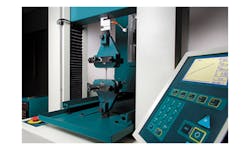ARC Technologies offered visitors to its EDI CON booth (No. 332) views of its expanding facilities in Amesbury, Mass., as well as the reasons for it expansion—with growing lines of RFI and EMI absorbing materials, as well as advanced measurement facilities to help customers evaluate their material needs at frequencies through 110 GHz. The company’s knowledge of materials science is extensive, and encompasses polymer and caulk systems, spray systems, cast systems, and resin systems.
Visitors to the booth were able to learn more about ARC’s Engineer’s Survival Kit, with an educational DVD on the company’s many material solutions and samples of various materials for noise and interference control across a wide range of materials. Examples of the company’s Wave-X were also on display, along with a demonstration of how the material can effectively control near-field EMI in a radio-frequency-identification (RFID) application. In addition to many standard forms of materials for EMI and RFI control, ARC Technologies also provides extensive solutions specially tailored to a customer’s specific applications.
One of the more impressive of the company’s material-based capabilities is in the area of test services, with test systems (see photo) for performing near-field and far-field material measurements, including permeability from 1 MHz to 110 GHz, permittivity from 500 MHz to 110 GHz, far-field reflection loss, insertion loss, and resistivity. Dielectric and magnetic material characterization can be performed from 2 to 40 GHz and from 75 to 110 GHz by means of focused beam testing.
Mechanical testing is also available for such material properties as coefficient of thermal expansion (CTE) and dynamic viscosity. Environmental compliance testing helps customers understand how their designs will withstand different humidity and temperature levels, salt fog, and various fluids.
The in-house lineup of test equipment is impressive, and includes standard gain horns from 2 to 18 GHz, high-frequency horns from 18 to 40 GHz, and low-frequency horns from 600 MHz to 2 GHz. Focused beam testing is used for complex permittivity and permeability characterization.
It can also measure reflection loss from normal on-axis to 60-deg. off-angle testing, via standard gain horns from 2.0 to 26.5 GHz, high-frequency horns from 26.5 to 40.0 GHz, and W-band horns from 75 to 110 GHz. Additional test gear includes four-point test probes and waveguide assemblies from 0.5 through 40.0 GHz.
About the Author
Jack Browne
Technical Contributor
Jack Browne, Technical Contributor, has worked in technical publishing for over 30 years. He managed the content and production of three technical journals while at the American Institute of Physics, including Medical Physics and the Journal of Vacuum Science & Technology. He has been a Publisher and Editor for Penton Media, started the firm’s Wireless Symposium & Exhibition trade show in 1993, and currently serves as Technical Contributor for that company's Microwaves & RF magazine. Browne, who holds a BS in Mathematics from City College of New York and BA degrees in English and Philosophy from Fordham University, is a member of the IEEE.


